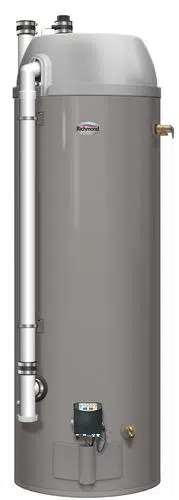Loading ...
Loading ...
Loading ...

12
Installing the water heater
This water heater is a direct vent appliance
and must be installed so that all air for
combustion is derived directly from the
outside atmosphere and all flue gases are
discharged to the outside atmosphere.
For proper installation of the vent and
combustion air-inlet systems, follow the
instructions as detailed in this manual.
DO NOT connect this water heater to
an existing vent or chimney - it must
be vented separately from all other
appliances.
NOTICE: This water heater is
approved to use the following materials
for vent and combustion air-inlet
systems:
PVC (Schedule 40, Cellular Core,
ASTM-F891)
PVC (DWV, ASTM-D2665)
PVC (Schedule 40, ASTM-D1785)
PVC (SDR Series, ASTM-D2241)
CPVC (CPVC 4120, ASTM-D2846)
CPVC (Schedule 40, ASTM-F441)
CPVC (SDR Series, ASTM-F442)
ABS (Schedule 40, DWV, ASTM-D2661)
ABS (Schedule 40, DWV, Cellular Core,
ASTM-F628)
DO NOT mix ABS pipe and fittings
with PVC or CPVC pipe fittings.
NOTICE: It is acceptable to
interchange PVC and CPVC pipe and
fittings.
The unit may be vented horizontally
through a wall or vertically through the
roof.
Vent and combustion air inlet pipe runs
must be adequately supported along both
vertical and horizontal lengths.
Maximum unsupported length is
recommended to be no more than 4 feet.
It is imperative that the first hanger
be located on the horizontal length
immediately adjacent to the first
90-degree elbow from the vertical rise of
vent pipe connected to the water heater.
The support method used should isolate
the vent and combustion air inlet pipes
from floor joists or other structural
members to help prevent the transmission
of noise and vibration.
Do not support, pin or otherwise secure
the vent and combustion air inlet systems
in a way that restricts the normal thermal
expansion and contraction of the chosen
vent material and air inlet pipe.
If the water heater is being installed as a
replacement for an existing power vented
water heater, a thorough inspection of
the existing vent and combustion air inlet
system must be performed prior to any
installation work.
Verify that the correct materials as
detailed above have been used, and
that the minimum or maximum vent
and combustion air inlet length and
terminal locations as detailed in this
manual have been met.
Carefully inspect the entire vent and
combustion air inlet systems pipes for
any signs of cracks or fractures,
particularly at the joints between
elbows or other fittings and the
straight length of vent pipe.
Check the vent and combustion air
inlet systems for signs of sagging or
other stresses in the joints as a result
of misalignment of any components
in the systems.
If any of these conditions are found,
they must be corrected in accordance
with the instructions in this manual
before completing the installation and
putting the water heater into service.
Additional installation
information for The Com-
monwealth of Massachusetts
is located on the back page of
this manual.
Vent and Combustion Air Inlet
High Altitude
Input rating of this water heater is
based on sea level operation. At higher
elevations the actual input rate may be
lower than the value listed on the rating
label due to the derating of natural gas and
LP gas. This water heater can be installed
at elevations up to 5,999 feet without any
change or modification.
For installation between 6,000 and 8,999
feet, refer to the Venting Information
tables on page 13 for maximum vent
lengths.
Installations above 8,999 feet are not
authorized.
Contact the local gas supplier for more
information.
WARNING: Failure to
install a water heater
suitable for the altitude at
the location it is intended to
serve, can result in improper
operation of the appliance
resulting in property
damage and/or producing
carbon monoxide gas, which
could result in personal
injury, or death.
DANGER: To avoid the
risk of fire, explosion, or
asphyxiation from carbon
monoxide, NEVER operate
the water heater unless it
is properly vented and the
Vent and Combustion Air
Inlet systems are properly
installed as detailed in the
"Vent and Combustion
Air Inlet" section of this
manual.
The vent pipe must overlap
a minimum of ½” on each
connection. It is important
that the vent pipe engages
fully into any pipe fitting
and be kept in that position
until the adhesive has fully
cured. DO NOT drill or
punch holes in the vent or
combustion air inlet pipe or
fittings.
NOTICE: This unit is
equipped with a Flammable
Vapor Sensor. Do not
apply power until enough
time has passed to allow the
vapors from the primer and
cement to dissipate.
!
Loading ...
Loading ...
Loading ...
